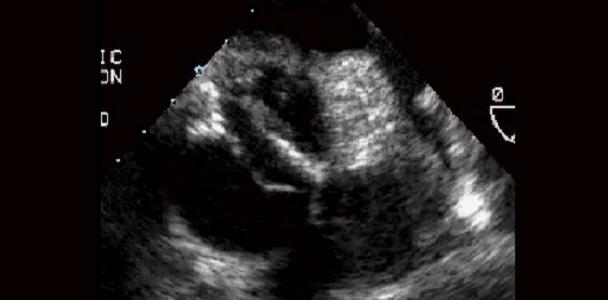TAVR for Bicuspid Aortic Stenosis? Registry Offers Clues to Safety, Outcomes
The propensity-matched data may offer some reassurances as transcatheter valve procedures move into younger patients.

WASHINGTON, DC—Registry data released earlier this week at the American College of Cardiology (ACC) 2017 Scientific Session suggest that transcatheter aortic valve replacement in patients with bicuspid aortic stenosis (AS) yields results that are similar to those seen in patients with tricuspid AS.
Procedure success, however, is lower in these patients, with more needing to be converted to surgical valve replacement.
Presenting the results at ACC, Sung-Han Yoon, MD (Cedars-Sinai Heart Institute, Los Angeles, CA), noted that procedural outcomes differed depending on whether patients received first- or second-generation devices. By 1 year, however, “all-cause mortality rates were similar between bicuspid and tricuspid AS, across early- and new-generation devices,” he said.
Yoon et al’s work was simultaneously published in the Journal of the American College of Cardiology.
An Excluded Group
The question of outcomes in patients with bicuspid aortic valve anatomy has become more pressing as transcatheter technology moves into a younger population, in which bicuspid disease is more common. Moreover, patients with bicuspid AS were typically excluded from the pivotal trials that led to device approval. In an interview with TCTMD, Yoon explained that while bicuspid AS is not a specific contraindication, the procedures are known to be riskier and associated with important limitations, including a higher incidence of paravalvular leak. Moreover, the guidelines do not address bicuspid AS directly—in the focused update released earlier this month, bicuspid AS is merely noted as an exclusion criteria in the original PARTNER, PARTNER 2, and COREVALVE high-risk trials.
For their analysis, Yoon and colleagues pooled data on patients with bicuspid AS who had undergone TAVR at one of 33 international sites, yielding a total of 576 patients. After propensity-score matching with patients treated for tricuspid AS, investigators had two groups of 546 patients. Mean age in both groups was 77 years—somewhat younger than patients treated in the major trials—with STS scores of approximately 4.5 in both groups. In all, 59% of the patients were treated with Sapien XT (Edwards Lifesciences) or CoreValve (Medtronic), while 41% received Sapien 3 (Edwards Lifesciences), Lotus (Boston Scientific), or Evolut R (Medtronic).
As Yoon showed in Washington, the rates of aortic root injury, need for a second valve implantation, and paravalvular leak were all higher in the bicuspid AS group than in the tricuspid AS group. Need for a new pacemaker, however, was identical between groups. Overall device success was significantly higher in the tricuspid AS group.
TAVR Outcomes by Anatomy
|
|
Bicuspid AS |
Tricuspid AS |
P Value |
|
Aortic Root Injury |
1.6% |
0 |
0.004 |
|
Second Valve Implantation |
4.8% |
1.5% |
0.002 |
|
Paravalvular Leak |
10.4% |
6.8% |
0.04 |
|
New Pacemaker |
15.4% |
15.4% |
NS |
|
Device Success |
85.3% |
91.4% |
0.002 |
Importantly, in further analyses looking at outcomes based on device type, Yoon et al found that the significant difference in device success persisted among patients treated with the first-generation devices (78.4% vs 86.9%; P = 0.005). This disappeared, though, when looking at patients treated with the newer-generation valves, where device success was also higher overall in both groups (95.1% vs 97.8%, P = 0.13).
Once successfully implanted, however, investigators saw no differences in 30-day outcomes including mortality, stroke, bleeding, major vascular complications, and acute kidney injury. At 1 year, all-cause mortality was nearly identical between groups at 11.4% for the tricuspid AS group and 11.2% for the bicuspid AS group, with no differences based on whether patients were treated with new- or older- generation devices.
To TCTMD, Yoon said he agreed that a randomized controlled trial testing TAVR devices in bicuspid AS would be “optimal,” but very low patient numbers mean registry data such as these may be the best operators are going to get. “Bicuspid valve disease is a very risky, challenging procedure for TAVR,” he said. “But now that devices have been developed to overcome the limitations [of their predecessors], particularly paravalvular leak, I think TAVR for bicuspid disease will be considered an acceptable choice of treatment.”
Commenting on the study for TCTMD, Stephan Windecker, MD (Bern University Hospital, Switzerland), noted that the registry is the largest data set he’s seen on this complex population and “advances our knowledge.”
While promising, he continued, “More data will be needed for several reasons. One, bicuspid anatomy is more prevalent in younger patients who are currently not undergoing TAVI. We will need investigations in these younger patients.”
Two, he continued, “frequently bicuspid anatomy is associated with more calcification and aortic root disease—another reason we will need to collect more data on which patients with bicuspid anatomy are good candidates for TAVI.”
And three: “the current data were selected retrospectively and we do not know how they were selected to undergo TAVI.”
Yoon and colleagues’ findings also underscored severe calcification, particularly calcification extending into the left ventricular outflow tract, as well as additional risk factors for aortic rupture or dissections, as factors that will have to be carefully weighed by heart teams in determining the best course of treatment for their patients.
Photo Credit: (Captured from Video) ©2014 American College of Cardiology. Used with permission from the American College of Cardiology
Shelley Wood was the Editor-in-Chief of TCTMD and the Editorial Director at the Cardiovascular Research Foundation (CRF) from October 2015…
Read Full BioSources
Yoon S-H, Bleiziffer S, De Baker O, et al. Procedural and clinical outcomes in transcatheter aortic valve replacement for bicuspid versus tricuspid aortic valve stenosis. J Am Coll Cardiol. 2017;Epub ahead of print.
Disclosures
- Yoon reports having no conflicts.
- Windecker has reported institutional grant/research support from Abbott, Boston Scientific, Edwards Lifesciences, Medtronic, and St. Jude Medical.


Comments